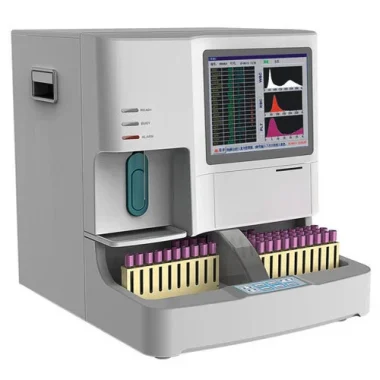Project Report For Hematology Analyzer Machine
Introduction
Project Report For Hematology Analyzer Machine is as follows.
Blood samples are tested using haematology analyzers. In the medical profession, they are used to perform white blood cell counts, complete blood counts, reticulocyte analyses, and coagulation studies. There are haematology analyzers for human blood and haematology analyzers for animal blood, which are beneficial for veterinarians, zoos, and research institutes. Closed vial testing and open sampling testing are two features that differ amongst haematology analyzers.
Certain haematology analyzers enable the user to select the desired method of testing. Other aspects to look for in a haematology analyzer include the sample size required, the kind and amount of testing modes, the speed with which the results are provided, automated flagging of findings that are outside of the normal range, and the capacity of test results it can store.
A laser beam is directed onto the cells as they travel through a small tube. A detecting device captures the reflection of the light that falls on the cells. In this scenario, we’re talking about laser flow cytometry. Flow cytometry is the most complex and costly technology available today. Fluorescence flow cytometry operates on the same concept as laser flow cytometry, with the exception of the kind of detection. Flow cytometry may be used to examine the morphology of cells as well as their internal and exterior structure.

Electrical impedance is used to calculate the number and volume of erythrocytes and thrombocytes. Within the device, EDTA blood is diluted with an isotonic solution and sucked through a capillary hole. Depending on their size, the cells pass through an electrical voltage field one by one, inducing a pulse – an increase in electrical resistance. This allows you to count the cells and distinguish between the largest and smallest.
The particle size distribution is measured using laser diffraction. When a laser beam travels over a sample of dispersed particles, the angular change of the intensity of diffuse light is measured. Large particles scatter light at a shallower angle to the laser beam, but microscopic particles scatter light at a greater depth. In this approach, the size of the particles that formed the diffraction picture may be calculated.
Benefits Of Hematology Analyzer Machine
Automated haematology analyzers provide a quick and accurate approach to perform key clinical tests, such as complete blood counts (CBC), saving laboratories time and reducing the chance of mistakes. Modern clinical haematology analyzers, on the other hand, can do much more, offering extended menus of test parameters and utilising innovative techniques such as flow cytometry to broaden the breadth of what may be learnt from a blood test. With so many haematology testing equipment alternatives on the market, it is critical to understand the distinctions between measuring methods, specs, and features. This tutorial breaks down the essential elements to consider when selecting a haematology analyzer for your lab.
Project Report Sample On
Hematology Analyzer Machine
Get Completely Custom Bankable Project Report
Market Potential of Hematology Analyzer Machine
The market for haematology analyser was estimated to be worth $1,962.40 million globally in 2020. It is expected to grow at a CAGR of 7.30% from 2021 to 2030, reaching $3,941.10 million by that time.
The rising frequency of blood illnesses such as anaemia, blood malignancies, hemorrhagic ailments, and blood infections is a significant driver driving market expansion. Furthermore, technical advances in haematology analyzers, increased demand for automated haematology analyzers, and growing preference for high sensitivity haematology analyzers all contribute to the market’s growth.
However, the high cost of haematology analyzers due to enhanced features and automation may stifle market growth. Furthermore, strict regulatory standards for haematology analyzers are projected to impede market growth. Growth potential in emerging economies, on the other hand, are likely to provide attractive opportunities for companies in the haematology analyzer market.
It is divided into two categories: fully automated haematology analyzers and semi-automated haematology analyzers. The fully-automated haematology analyzer category led the worldwide market in 2020 and is expected to maintain its dominance throughout the forecast period. This is due to an increase in demand for automated haematology equipment, as well as technical developments and the incorporation of fundamental flow-cytometry techniques in automated haematology analyzers.

